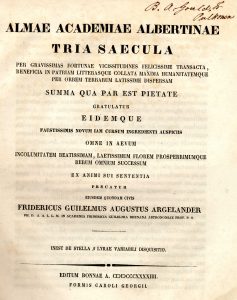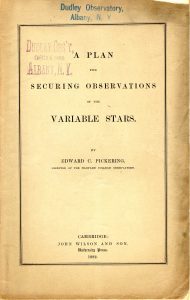From the Library: “A Plan for Securing Observations of the Variable Stars”
Pamphlets were the blog posts of the nineteenth century. They could be quickly and cheaply produced, then distributed either for free or for a few pennies to cover printing costs. If popular, they could be bound and go from being ephemera to being permanent. One fan of the preserving the media, Samuel Johnson, explained the appeal:
From pamphlets, consequently, are to be learned the progress of every debate; the various state [sic] to which the questions have been changed; the artifices and fallacies which have been used, and the subterfuges by which reason has been eluded; in such writings may be seen how the mind has been opened by degrees, how one truth has led to another, how error has been disentangled …
Because of their quick production, pamphlets could be part of larger discussion, and so they let us see the discussion in motion instead of in retrospect.
The wide reach and low cost of pamphlets made them useful in another way: a person who didn’t have a lot of money could still get the word out. Enter Edward Pickering, director of the Harvard Observatory. In 1882, he was running out of money. He had tried everything, from soliciting donation to selling the lawn clippings, but there were always more demands than there was money to hire staff.
At that point, he was particularly interested in variable stars. These stars appear to pulse; they brighten and dim in a regular pattern with a period that can last for seconds or years depending on the star. Interest in these stars seems to start with German astronomer Friedrich Wilhelm Argelander, and came to America through one of his students, our own Benjamin Gould.
Of course, figuring out the variable brightness and the length of the period of a variable star requires making hundreds of observations over a long stretch of time. Most astronomers don’t have the kind of time. Gould hit upon the idea of inviting amateur astronomers to pitch in. He made a call through his publication, the Astronomical Journal, asking for assistance. He, and his student Seth Chandler, publish pamphlets instructing people on how to record their observations of a variable star.
Pickering borrowed that idea. In 1882, he published a pamphlet, “A Plan for Securing Observations of the Variable Stars.” For the most part Pickering followed the same approach as Gould and Chandler. But there was one major addition:
“Much valuable assistance might be rendered by a class whose aid in such work has usually been overlooked. Many ladies are interested in astronomy and own telescopes, but with two or three noteworthy exceptions their contributions to the science have been almost nothing. Many of them have the time and inclination for such work, and especially among the graduates of women’s colleges are many who have had abundant training to make excellent observers. As the work may be done at home, even from an open window, provided the room has the temperature of the outer air, there seems to be no reason why they should not thus make an advantageous use of their skill. It is believed that it is only necessary to point the way to secure most valuable assistance. The criticism is often made by the opponents of the higher education of women that, while they are capable of following others as far as men can, they originate almost nothing, so that human knowledge is not advanced by their work. This reproach would be well answered could we point to a long series of such observations as are detailed below, made by women observers.”


Pickering had hired Williamina Fleming as a computer the year before, and she became the first of the women we now call the “Harvard Computers.” In this little pamphlet we can see the potential working itself out in Pickering’s head.
That little teaser at the end – “here’s your chance to prove them wrong” – actually came to pass. In 1908, one of Harvard’s Computers named Henrietta Swan Leavitt was able to work out the relationship between the brightness of a variable star and the period of its bright/dim cycle. This meant that an astronomer could know the actual brightness of a variable star, and using the amount of the light that makes it to earth work backwards to determine the distance. This discovery was essential for working out the size of our universe.
These pamphlets, from Argelander, Chandler and Pickering, are part of Dudley’s pamphlet collection. We owe a debt to Katherine Brent, student at the University at Albany’s Library Science program and associate librarian at SUNY Cobleskill, for her work arranging and describing this incredibly valuable collection.
